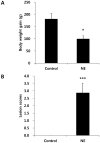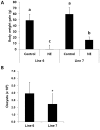Transcriptional profiles of host-pathogen responses to necrotic enteritis and differential regulation of immune genes in two inbreed chicken lines showing disparate disease susceptibility
- PMID: 25504150
- PMCID: PMC4263703
- DOI: 10.1371/journal.pone.0114960
Transcriptional profiles of host-pathogen responses to necrotic enteritis and differential regulation of immune genes in two inbreed chicken lines showing disparate disease susceptibility
Abstract
Necrotic enteritis (NE) is an important intestinal infectious disease of commercial poultry flocks caused by Clostridium perfringens. Using an experimental model of NE involving co-infection with C. perfringens and Eimeria maxima, transcriptome profiling and functional genomics approaches were applied to identify the genetic mechanisms that might regulate the host response to this disease. Microarray hybridization identified 1,049 transcripts whose levels were altered (601 increased, 448 decreased) in intestinal lymphocytes from C. perfringens/E. maxima co-infected Ross chickens compared with uninfected controls. Five biological functions, all related to host immunity and inflammation, and 11 pathways were identified from this dataset. To further elucidate the role of host genetics in NE susceptibility, two inbred chicken lines, ADOL line 6 and line 7 which share an identical B2 major histocompatibility complex haplotype but differ in their susceptibility to virus infection, were compared for clinical symptoms and the expression levels of a panel of immune-related genes during experimental NE. Line 6 chickens were more susceptible to development of experimental NE compared with line 7, as revealed by decreased body weight gain and increased E. maxima oocyst shedding. Of 21 immune-related genes examined, 15 were increased in C. perfringens/E. maxima co-infected line 6 vs. line 7 chickens. These results suggest that immune pathways are activated in response to experimental NE infection and that genetic determinants outside of the chicken B complex influence resistance to this disease.
Conflict of interest statement
Figures




Similar articles
-
High-throughput sequencing reveals differing immune responses in the intestinal mucosa of two inbred lines afflicted with necrotic enteritis.Vet Immunol Immunopathol. 2015 Aug 15;166(3-4):116-24. doi: 10.1016/j.vetimm.2015.06.008. Epub 2015 Jun 25. Vet Immunol Immunopathol. 2015. PMID: 26182861
-
Relative disease susceptibility and clostridial toxin antibody responses in three commercial broiler lines coinfected with Clostridium perfringens and Eimeria maxima using an experimental model of necrotic enteritis.Avian Dis. 2013 Sep;57(3):684-7. doi: 10.1637/10496-011813-ResNote.1. Avian Dis. 2013. PMID: 24283139
-
Expression analysis of cytosolic DNA-sensing pathway genes in the intestinal mucosal layer of necrotic enteritis-induced chicken.Vet Immunol Immunopathol. 2016 Feb;170:1-12. doi: 10.1016/j.vetimm.2015.12.010. Epub 2015 Dec 31. Vet Immunol Immunopathol. 2016. PMID: 26872625
-
The role of host genetic factors and host immunity in necrotic enteritis.Avian Pathol. 2016 Jun;45(3):313-6. doi: 10.1080/03079457.2016.1154503. Avian Pathol. 2016. PMID: 26957203 Review.
-
Genetics and genomics of susceptibility and immune response to necrotic enteritis in chicken: a review.Mol Biol Rep. 2018 Feb;45(1):31-37. doi: 10.1007/s11033-017-4138-8. Epub 2017 Dec 20. Mol Biol Rep. 2018. PMID: 29264734 Review.
Cited by
-
Role of Physiology, Immunity, Microbiota, and Infectious Diseases in the Gut Health of Poultry.Vaccines (Basel). 2022 Jan 22;10(2):172. doi: 10.3390/vaccines10020172. Vaccines (Basel). 2022. PMID: 35214631 Free PMC article. Review.
-
A comprehensive review of experimental models and induction protocols for avian necrotic enteritis over the past 2 decades.Front Vet Sci. 2024 Jul 24;11:1429637. doi: 10.3389/fvets.2024.1429637. eCollection 2024. Front Vet Sci. 2024. PMID: 39113718 Free PMC article. Review.
-
Histological and Comparative Transcriptome Analyses Provide Insights into Small Intestine Health in Diarrheal Piglets after Infection with Clostridium Perfringens Type C.Animals (Basel). 2019 May 23;9(5):269. doi: 10.3390/ani9050269. Animals (Basel). 2019. PMID: 31126046 Free PMC article.
-
RNA-seq Profiles of Immune Related Genes in the Spleen of Necrotic Enteritis-afflicted Chicken Lines.Asian-Australas J Anim Sci. 2015 Oct;28(10):1496-511. doi: 10.5713/ajas.15.0143. Asian-Australas J Anim Sci. 2015. PMID: 26323406 Free PMC article.
-
Impacts of Microbial based Therapy on Growth Performance, Intestinal Health, Carcass Traits and Economic Efficiency of Clostridium perfringens-Infected Cobb and Arbor Acres Broilers.Vet Med Sci. 2021 May;7(3):773-791. doi: 10.1002/vms3.412. Epub 2021 Mar 15. Vet Med Sci. 2021. PMID: 33720539 Free PMC article.
References
-
- Hermans PG, Morgan KL (2007) Prevalence and associated risk factors of necrotic enteritis on broiler farms in the United Kingdom; a cross-sectional survey. Avian Pathol 36:43–51. - PubMed
-
- Lee K, Lillehoj HS, Li G, Park MS, Jang SI, et al. (2011) Identification and cloning of two immunogenic Clostridium perfringens proteins, elongation factor Tu (EF-Tu) and pyruvate:ferredoxin oxidoreductase (PFO) of C. perfringens. Res Vet Sci 91:e80–86. - PubMed
-
- Van Immerseel F, De Buck J, Pasmans F, Huyghebaert G, Haesebrouck F, et al. (2004) Clostridium perfringens in poultry: an emerging threat for animal and public health. Avian Pathol 33:537–549. - PubMed
-
- Timbermont L, Lanckriet A, Gholamiandehkordi AR, Pasmans F, Martel A, et al. (2009) Origin of Clostridium perfringens isolates determines the ability to induce necrotic enteritis in broilers. Comp Immunol Microbiol Infect Dis 32:503–512. - PubMed
Publication types
MeSH terms
LinkOut - more resources
Full Text Sources
Other Literature Sources
Molecular Biology Databases

